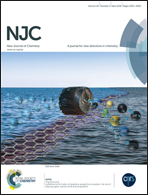Effect of the N-based ligands in copper complexes for depolymerisation of lignin†
Abstract
Several organic soluble N-based ligands and their copper complexes were firstly investigated as catalysts to depolymerise organosolv lignin in the organic solvent, dimethylformamide (DMF) and an ionic liquid (1-ethyl-3-methylimidazolium xylenesulfonate, [emim][ABS]). The results of screening depolymerisation reactions in DMF and [emim][ABS] showed that all the copper–amine complexes catalysed lignin depolymerisation more efficiently in ionic liquids than in DMF. Among the seven types of ligands, copper complexes with two types of ligands (E)-N-(pyridin-2-ylmethylene)aniline and (E)-4-methoxy-N-(pyridin-2-ylmethylene)aniline depolymerised the lignin more efficiently than the others. These two copper complexes with the N-based ligand were further studied to determine the most efficient conditions for the depolymerisation of the lignin. The most effective depolymerisation by conditions involved treatment at 180 °C for 12 h in [emim][ABS]. Cyclic voltammetric studies were carried out to investigate the reversible potential associated with the copper centers of their complexes with these N-based ligands. The results suggest that two types of ligands have more positive reversible potentials than those of other copper complexes.


 Please wait while we load your content...
Please wait while we load your content...